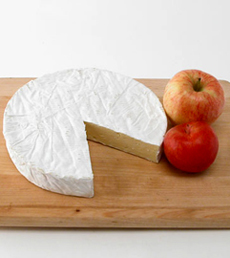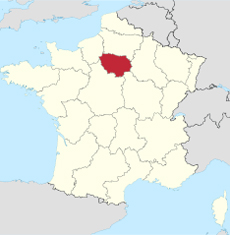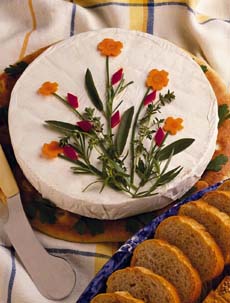 Brie is a larger format than the 4.5-inch diameter Camembert. While there are “baby Bries” made in the same size, a standard wheel of Brie is 9 to 15 inches in diameter. Brie photo courtesy iGourmet. Brie is a larger format than the 4.5-inch diameter Camembert. While there are “baby Bries” made in the same size, a standard wheel of Brie is 9 to 15 inches in diameter. Brie photo courtesy iGourmet.
|
STEPHANIE ZONIS focuses on good foods and the people who produce them.
|
|
May 2007
Last Updated November 2011
|
 |
Brie & Camembert: The Difference
Page 2: Brie Cheese
This is Page 2 of a three-page article. Click on the black links below to visit other pages.
Origin Of Brie
Supposedly, Brie has been made since at least the fifth century, although there doesn’t seem to be any documentation to support this claim. The name comes from the Brie region located in the Île-de-France region of France. The AOC-designated areas are in the Seine-et-Marne department of Île-de-France.
According to legend, the Emperor Charlemagne is said to have tried Brie at a monastery in Reuil-en-Brie in 774. He instantly become a devoted fan. In 1815, the Prince de Tallyrand named Brie “Le Roi de Fromages,” The King of Cheeses.
While many Brie cheeses are made in Île-de-France, only two Bries have AOC designations.
- Brie de Meaux is made in the region of Meaux (pronounced “mow”), a city some 50 kilometers east of Paris on the banks of the Marne River.
- Brie de Melun is made in the area of Melun, 50 kilometers south of Paris and 60 kilometers southeast of Meaux. Brie de Melun has more robust flavors than Brie de Meaux. It is made in smaller wheels, 11 inches, but is thicker, 1.5 inches. Brie de Melun is made only of raw milk and is not exported, according to Steve Jenkins.
|
|

The Île-de-France region of France. Image courtesy Wikimedia. The city of Paris is located in the center of the region. |
*Roquefort has also been called the King of Cheeses, and Brie the Queen of Cheeses. France has made no official proclamation to end the confusion.
Brie In Modern Times
Jenkins notes that, until the 1870 Franco-Prussian War, the plains of Brie were entirely given over to dairy cattle pastures. But the war wreaked havoc on the area’s dairy businesses, which never fully recovered.
Land ownership shifted from small farmers to industry, and by 1914 only half as many cattle were being raised there, mostly for beef.
Cheese production was slow to recuperate after the First World War, and by the 1950s most Brie production had become industrialized. Like Camembert, the general name “Brie” is not AOC-protected, so it can appear on cheese produced in other regions and other countries, even on pasteurized impostors.
If The Wheel Is Large, It’s Brie
The process used to make Brie is unsurprisingly very similar to that used for Camembert, but Brie is made in larger wheels, ranging from about 1 to 6 pounds (500g to 3kg) in weight, 9 to 15 inches in diameter and 1 to 1.5 inches in thickness, although it also can be found in 8-ounce disks.
Brie is most flavorful when served at room temperature. Remove Brie from the refrigerator about 45 minutes before serving.
See the next page for how to serve Brie and Camembert.
|
|

The larger size of the Brie wheel allows for decoration with flowers and herbs. Photo courtesy WMMB. |
The Difference Between Brie & Camembert: Summary
- Recipe: Similar; Brie often has more fat than Camembert
(there are triple-crème Bries)
- Region: Île-de-France for Brie, Normandy for Camembert
- Terroir: Different
- Size: Different: Camembert, 4.5" in diameter, is never made in large wheels. Brie is traditionally made in wheels from 9" to 17" in diameter; although for today’s supermarket consumers, “Baby Brie” is made in the same size as Camembert (giving rise to confusion, as they look and taste alike).
- Origin: Brie can be dated to 774 C.E.; Camembert much later, to 1791. Camembert may have been the result of a Brie recipe given to Marie Harel by a priest she was hiding from the guillotine.
Continue To Page 3: Selecting A Ripe Brie Or Camembert
Go To The Article Index Above
Lifestyle Direct, Inc. All rights reserved. Images are the copyright of their respective owners.

|




 Brie is a larger format than the 4.5-inch diameter Camembert. While there are “baby Bries” made in the same size, a standard wheel of Brie is 9 to 15 inches in diameter. Brie photo courtesy iGourmet.
Brie is a larger format than the 4.5-inch diameter Camembert. While there are “baby Bries” made in the same size, a standard wheel of Brie is 9 to 15 inches in diameter. Brie photo courtesy iGourmet. 
